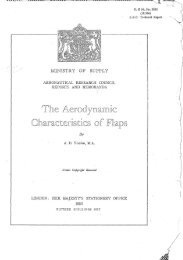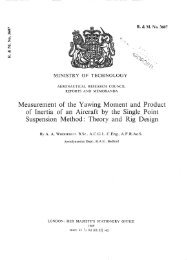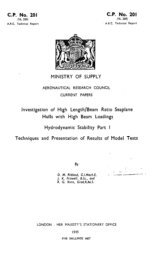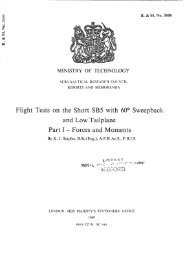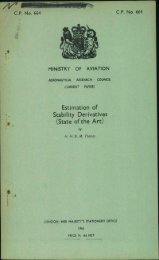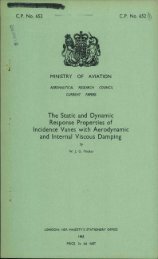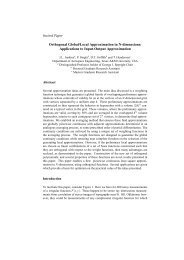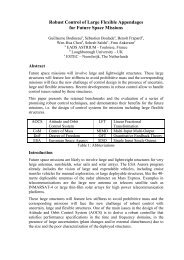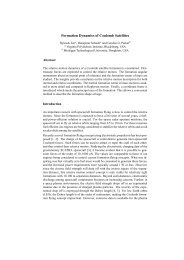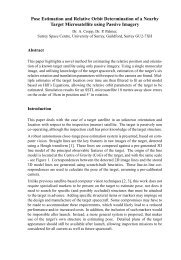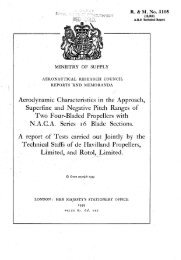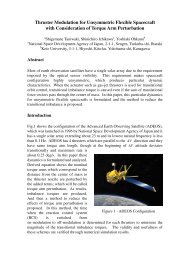A Survey of Unsteady Hypersonic Flow Problems
A Survey of Unsteady Hypersonic Flow Problems
A Survey of Unsteady Hypersonic Flow Problems
Create successful ePaper yourself
Turn your PDF publications into a flip-book with our unique Google optimized e-Paper software.
- 26 -<br />
This simple form <strong>of</strong> the method ignores the<br />
disturbances frcm the body surface at the shock wave<br />
gradient in the flow, and. the picture <strong>of</strong> the flow 33<br />
effect <strong>of</strong> the reflection <strong>of</strong><br />
ana from regions <strong>of</strong> entropy<br />
consisting <strong>of</strong> a straight<br />
shock wave from the nose followed by a simple expansion is not in general<br />
adequate for the whole field. The significance <strong>of</strong> these reflections has been<br />
examined. in Ref. 28 and it is found that, at the body surface, the reflected<br />
disturbances tend to cancel each other for the condition y > l-3. Since this<br />
condition holds for most flows <strong>of</strong> practical interest, the simple theory is<br />
adequate to give surface pressure information.<br />
For thin two-dimensional sections undergoing small-amplitude sinusozdal<br />
distortions about zero mean incidence in flow3 <strong>of</strong> sufficiently high Mach numbers,<br />
the expressions for the nose shock conditions and for the Prandtl-Meyer relation<br />
can be simplified and, as a result, a closed-form expression for the lift<br />
distribution can be developed. For a symmetrical section the expression is 19 :<br />
Pe‘PU = ze ikt<br />
PC0<br />
c &[(8)"-II+1<br />
(y-1 1<br />
1 +- Ei.J 'ii(x)<br />
+ 2 3<br />
- k(O)<br />
X? - + ikg(0) 1 emilm +<br />
CL ax<br />
+ yi& [miq x) -1 J<br />
2y/(v-1)<br />
h(O)<br />
- + ikg(O)] emikx +[z + ikg]] . . . (2.49)<br />
ax<br />
where g(x) is the complex amplitude <strong>of</strong> the time-dependent motion; n and m<br />
are the rates-<strong>of</strong> change <strong>of</strong> pressure and Mach number at the nose with change <strong>of</strong><br />
nose angle; "N is the value <strong>of</strong> the Mach number at the nose for sero distortion;<br />
@ is the value <strong>of</strong> the shock inclination angle for zero distortion; and z(x)<br />
is the turning angle <strong>of</strong> the flow from the nose due to thichess alone.<br />
For conditions where the simplified expressions for the nose conditions<br />
and the expansion could not be applied, where the amplitude was not small, or<br />
when real gas effect3 became important, numerical methods would have tL be<br />
employed.<br />
The shock-expansion method can be applied to slender three-dimensional<br />
bodies for which MS is greater than a limit around unity (the limit is not<br />
rigid; errors become greater as unity is approached) because it can be shown<br />
for such bodies that the flow on the body surface is locally two-d' TJym; :",<br />
planes normal to the body surface and tangential to the streamlines<br />
as a consequence <strong>of</strong> this, the Prandtl-Meyer relation can be applied along the<br />
surface streamlines. The surface streamlines can be shown to follow closely the<br />
surface geodesics through the nose. A geodesic is a line on a surface such that<br />
at any point its projection on the tangent plane at that point has zero curvature;<br />
it is determined by the geometry <strong>of</strong> the surface so that once the initial direction<br />
<strong>of</strong> the surface streamlines is known the expansion conbtiona can, in principle,<br />
be determined from the geometry <strong>of</strong> the surface. The condition3 at the nose <strong>of</strong><br />
the body must, <strong>of</strong> course, be found from the flow over a cone hating the 3ame<br />
cross-section as the body at the nose. This presents a limitation for the<br />
application <strong>of</strong> the method since the flow is known only for cones with certain<br />
simple cross-sections at small angles <strong>of</strong> yaw.<br />
x



